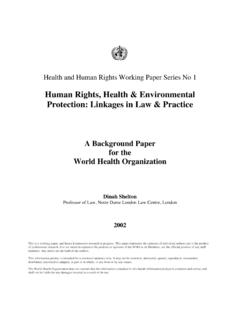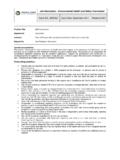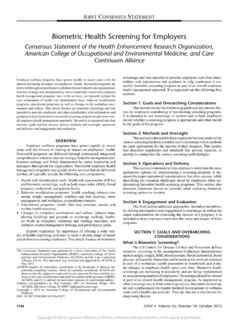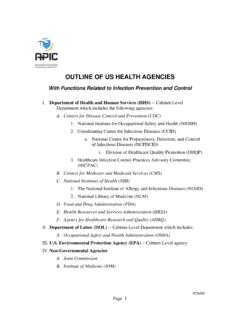Transcription of Sensible health and safety at work - The regulatory ...
1 Sensible health and safety at work The regulatory methods used in Great Britain An account of the approach of the health and safety Commission Contents Page Summary 1. Why we have written this account 5. Methods that are used by the HSE and LAs 7. The main features of our approach 9. Sensible health and safety in action an illustration of our methods being used together to combat back injuries 14. Appendix 1 Sensible health and safety a summary of our evidence and 15. comments our consultees made to us Summary 1. We have written this to meet a commitment in the health and safety Commission's Strategy for Workplace health and safety in Great Britain to 2010 and Beyond to develop a clear evidence-based intervention strategy that will help us focus on our core business and the right interventions where we are best placed to reduce workplace injury and ill health .
2 2. In developing it we have listened to those with an interest in health and safety at work;. looked at the evidence of what works; drawn on our long experience of applying the methods in this document; and responded to the recent Hampton report. It seeks to maintain the best from our long and successful past, adapted to fit the rapidly changing world of work that we are all now experiencing. 3. Its purpose is to explain to everyone who has an interest in health and safety at work how the main regulators the health and safety Executive (HSE) and Local Authority Environmental health Departments (LAs) will act to bring about good standards, without wasting either their own resources, or those of the many organisations which have duties under the health and safety at Work Act (HSW Act).
3 Throughout this guide, terms such as we , our and us refer to the regulatory staff of LAs and HSE alike; we have identical functions under the HSW Act. 4. It illustrates our past approach, and our future intentions, We fully support the including how we will respond to some of the recommendations need for the most of the Treasury report Reducing administrative burdens: efficient and effective inspection and enforcement' by Philip Hampton effective use of HSE. published in March 2005, which we strongly support. In resources. particular it commits us to a greater concentration on areas of CBI. poor performance and high risk and it promotes consistency of approach by HSE and LAs.
4 5. This document explores the setting in which we work as regulators, the factors affecting our choice of interventions and the broad principles for our future approach. We want it to be of value to everyone interested in health and safety , so we have kept it quite brief and as light in jargon as such a technical subject allows. 6. It is supported by a Guide for regulators'1 which is aimed at staff in HSE and LAs whose role is to protect and raise standards of workplace health and safety either directly or through their engagement with others. A clear message from our evidence and the consultation we have carried out is that there is no simple mix of methods that will work everywhere; a tailored approach is required.
5 Some hazards and risks need a different approach; some sectors will respond better to different mixes of our methods. So the Guide for regulators' applies the principles set out here to specific health and safety topics in different industrial sectors and sizes of organisation. 7. This account of our approach and the supporting guide for regulators deal with ways to reduce injury, ill health and working days lost. They do not cover HSE's work with the 1. The guide for regulators is under development. We intend that it will be published early in 2006. -1- small number of industries that must get HSE's permission to operate, such as the offshore oil industry HSE call this their major hazards' work.
6 8. We have developed some guiding points to shape our future approach. Our reasons are set out in the main body of the document. In summary, our guiding points are: Concentrating on priorities, risk, and poor performance (1) We will focus our attention onto poor performers and large organisations where health and safety priorities suggest there might be significant levels of risk, or indeed of actual harm. (2) We will maintain credibly large programmes of inspection and other frontline activity aimed at finding out how well organisations which have the risks associated with our priority topics control them, and we will concentrate our inspection effort on those whose performance is poor.
7 Choosing which methods to use (3) As we have more evidence about some of our techniques than about others, we will tend to favour the tried and tested over the speculative when making decisions on the balance of our use of resources, but we will avoid undue caution; we will pilot and evaluate new techniques that we introduce. (4) We will make greater use of the methods that take effect before and at the point of creation of risk, favouring those that require comparatively less resource from the regulator in relation to their benefits: x motivating senior managers;. x improving design of processes and products;. x taking initiatives across whole sectors; and x promoting education and awareness.
8 Explaining the choices we make (5) We will make our reasons for intervening explicit, so that everyone who has contact with us understands why, and what we want to achieve; aiming for as few interventions as are necessary to achieve the results we seek. (6) We will move towards a position where every intervention has a clearly stated reason and in general forms part of a broader planned approach (such as an industry- wide campaign). Judging performance (7) We will maintain risk-rating systems to guide our choice of organisations to inspect and we will develop a system for openly rating the performance of organisations. Meeting the needs of small businesses (8) We will provide more and better advice, for small firms in particular.
9 For example, through the Workplace health Direct regional pathfinders we will provide active expert support to small firms on managing health risks and return to work, free from regulatory pressure. These Pathfinders will be fully evaluated. -2- (9) We will maintain programmes of contact with small firms, including inspections, and increase the contact that we achieve through other means such as large-scale awareness events. Engaging with the workforce (10) There is clear evidence that engaging the workforce benefits health and safety and this will be a renewed priority for us. Campaigns and publicity (11) We will make greater use of campaign techniques, using a wide range of the methods available to us, and strengthen the intelligence on which we base our campaigns.
10 (12) We will multiply the benefits of our frontline work through publicity and good communication, to influence and deter others. Balancing preventive work with investigation (13) In future we will target incidents for investigation that arise from our priority topics as well as those that result in fatal and major injuries. Enforcement (14) We will continue to make appropriate use of our enforcement powers in line with the HSC Enforcement Policy Statement (EPS) and other relevant Codes (eg the Code for Crown Prosecutors). We will follow up all enforcement actions we take, and make sure that the circumstances and causes have been dealt with.















